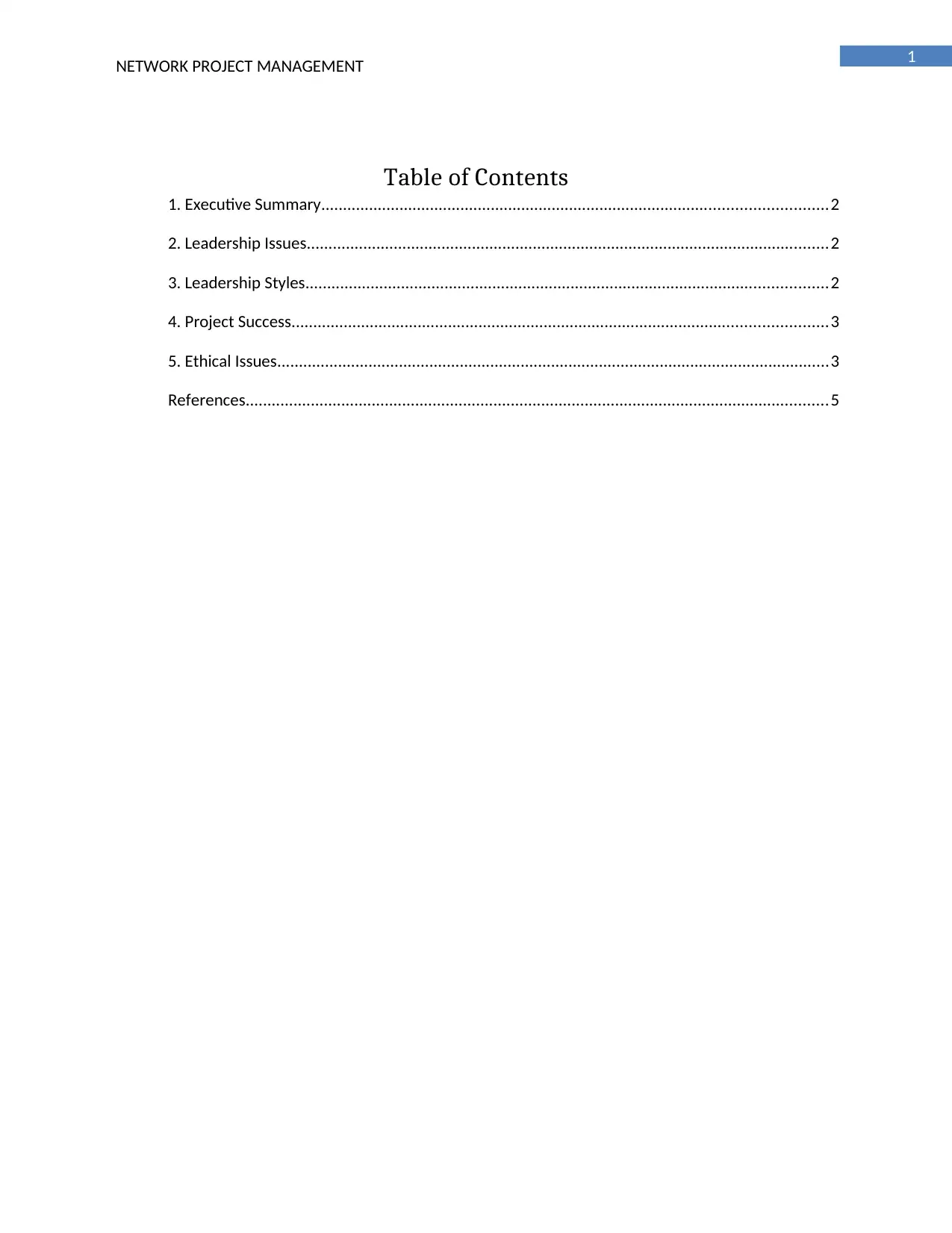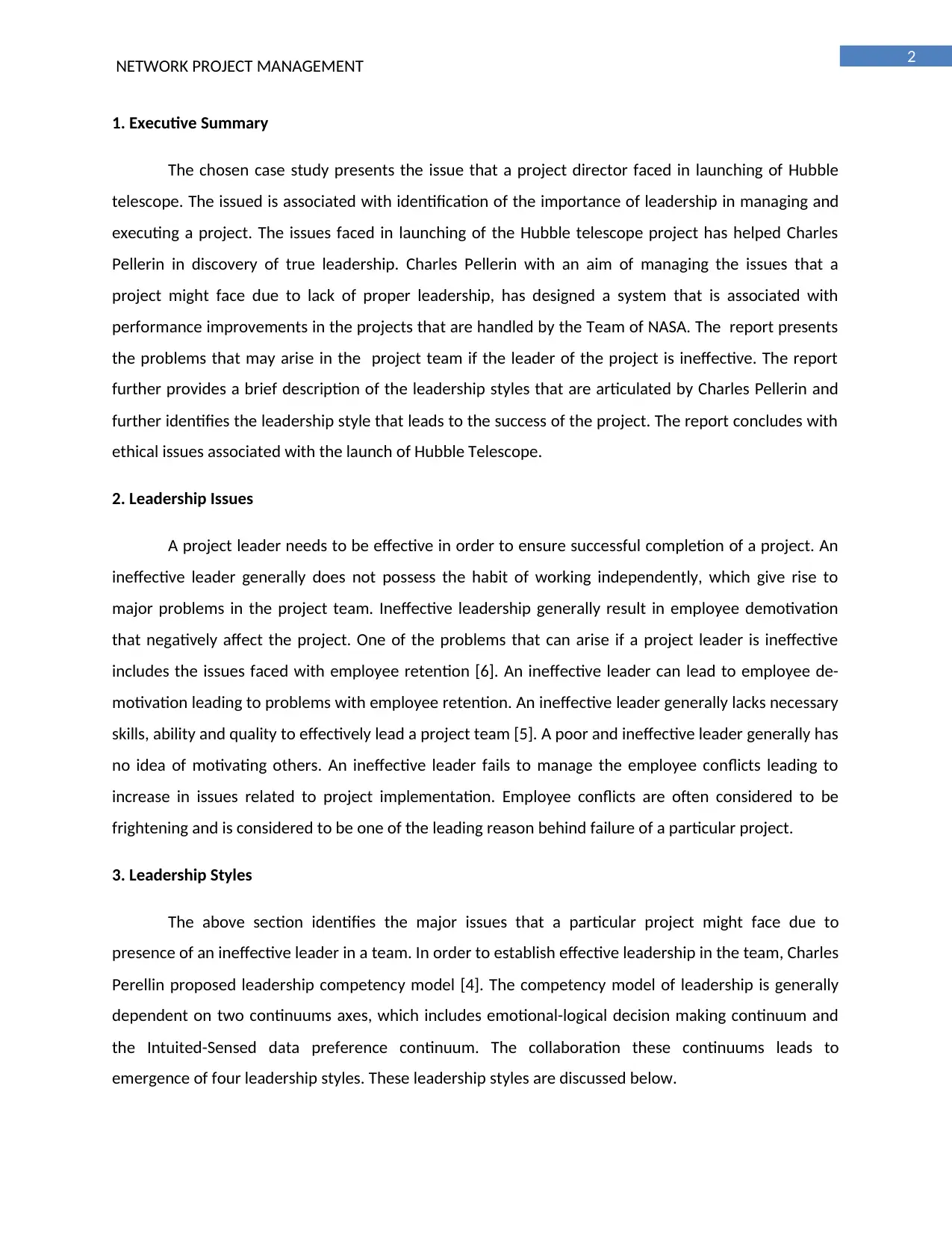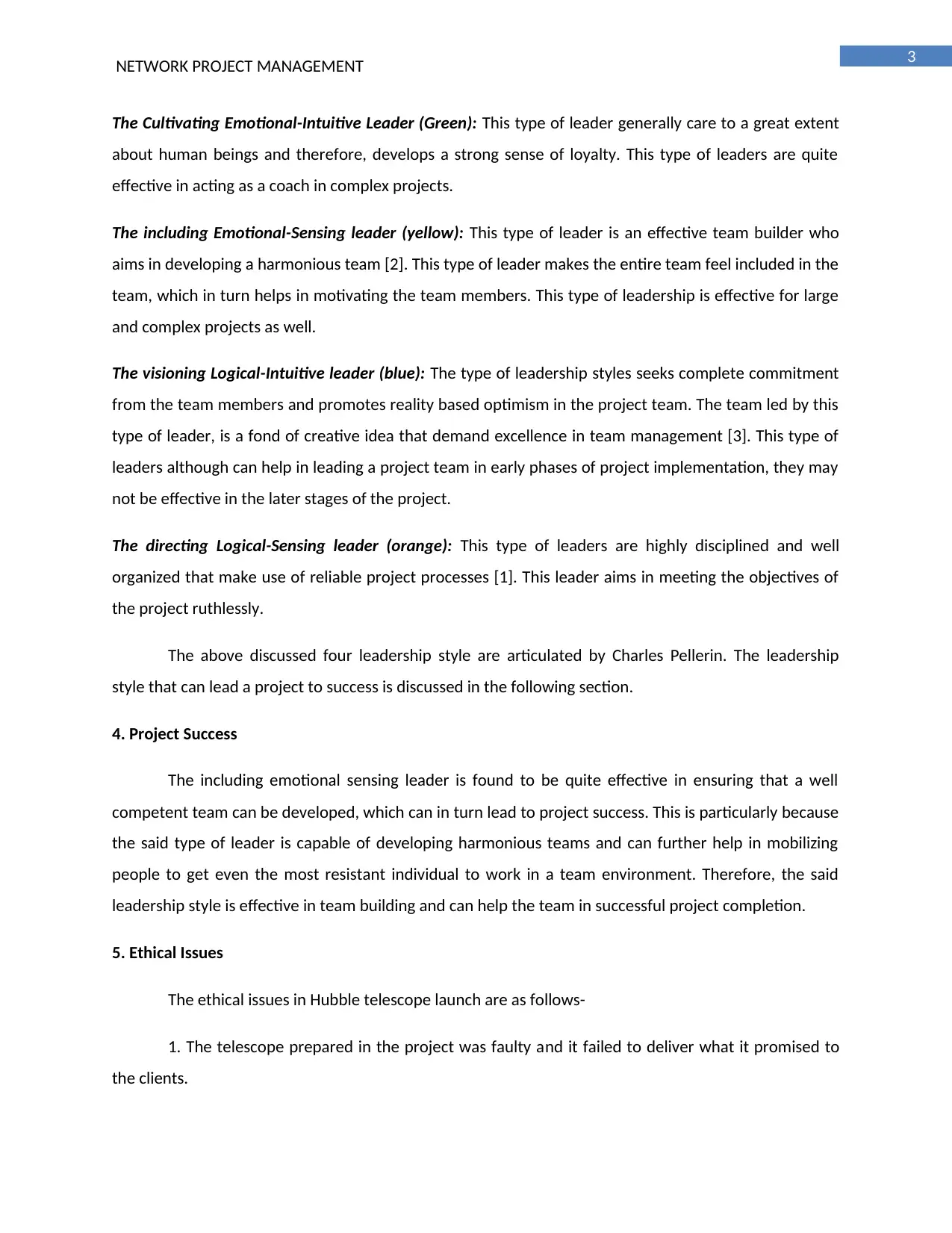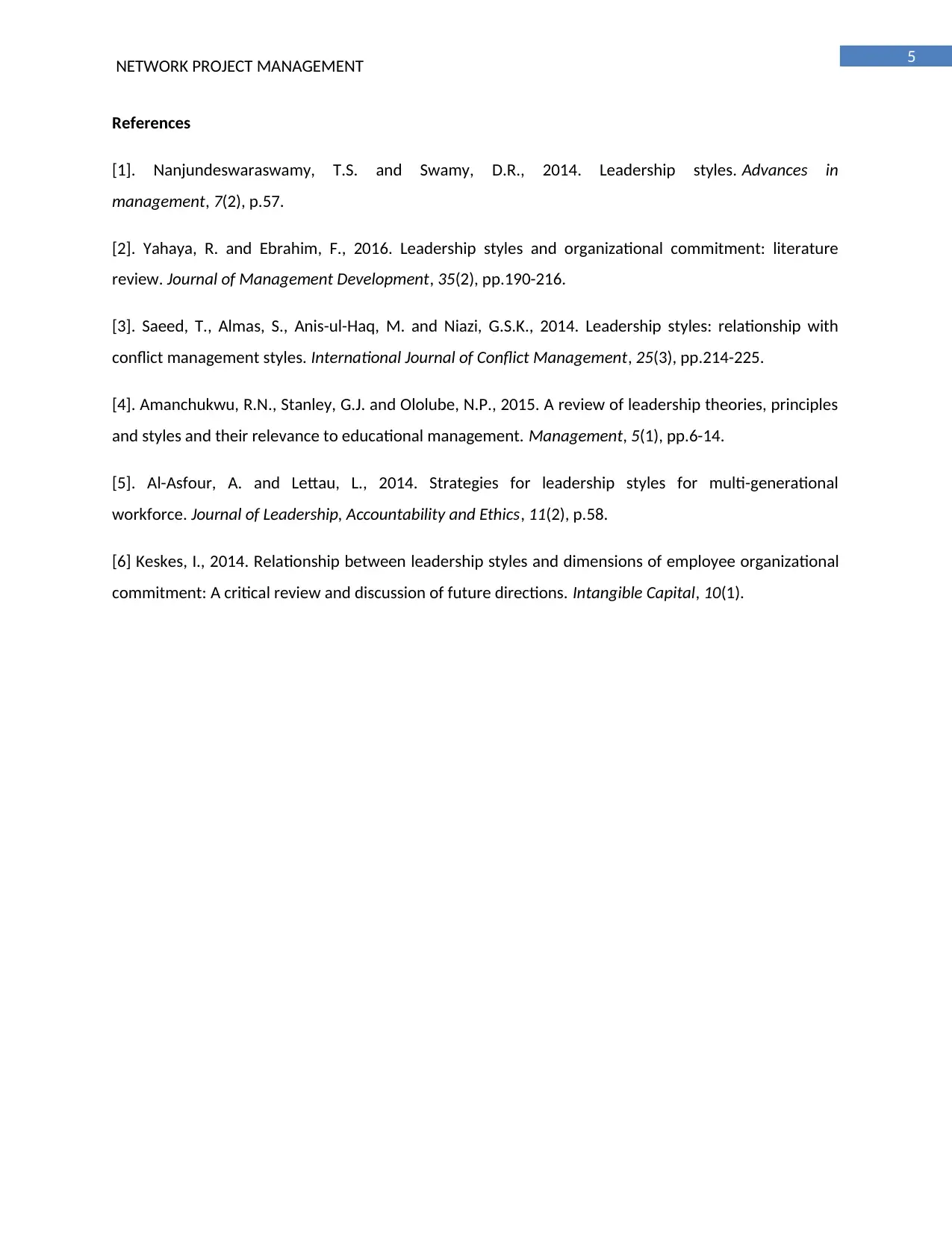Network Project Management: Leadership, Ethics and Project Success
VerifiedAdded on 2023/01/23
|6
|1203
|38
Report
AI Summary
This report delves into the critical role of leadership in network project management, using the Hubble telescope launch as a case study. It examines the issues arising from ineffective leadership, such as employee demotivation and conflicts. The report explores Charles Pellerin's leadership competency model, identifying four leadership styles: cultivating emotional-intuitive, including emotional-sensing, visioning logical-intuitive, and directing logical-sensing. It emphasizes the emotional-sensing leader's effectiveness in building harmonious teams and driving project success. Furthermore, the report addresses the ethical issues associated with the Hubble telescope project, including faulty equipment and potential research risks, and suggests the importance of effective leadership in addressing these challenges.

Running head: NETWORK PROJECT MANAGEMENT
Network Project Management
Name of Student
Name of University
Author Note
Network Project Management
Name of Student
Name of University
Author Note
Paraphrase This Document
Need a fresh take? Get an instant paraphrase of this document with our AI Paraphraser

1
NETWORK PROJECT MANAGEMENT
Table of Contents
1. Executive Summary....................................................................................................................2
2. Leadership Issues........................................................................................................................2
3. Leadership Styles........................................................................................................................2
4. Project Success...........................................................................................................................3
5. Ethical Issues...............................................................................................................................3
References......................................................................................................................................5
NETWORK PROJECT MANAGEMENT
Table of Contents
1. Executive Summary....................................................................................................................2
2. Leadership Issues........................................................................................................................2
3. Leadership Styles........................................................................................................................2
4. Project Success...........................................................................................................................3
5. Ethical Issues...............................................................................................................................3
References......................................................................................................................................5

2
NETWORK PROJECT MANAGEMENT
1. Executive Summary
The chosen case study presents the issue that a project director faced in launching of Hubble
telescope. The issued is associated with identification of the importance of leadership in managing and
executing a project. The issues faced in launching of the Hubble telescope project has helped Charles
Pellerin in discovery of true leadership. Charles Pellerin with an aim of managing the issues that a
project might face due to lack of proper leadership, has designed a system that is associated with
performance improvements in the projects that are handled by the Team of NASA. The report presents
the problems that may arise in the project team if the leader of the project is ineffective. The report
further provides a brief description of the leadership styles that are articulated by Charles Pellerin and
further identifies the leadership style that leads to the success of the project. The report concludes with
ethical issues associated with the launch of Hubble Telescope.
2. Leadership Issues
A project leader needs to be effective in order to ensure successful completion of a project. An
ineffective leader generally does not possess the habit of working independently, which give rise to
major problems in the project team. Ineffective leadership generally result in employee demotivation
that negatively affect the project. One of the problems that can arise if a project leader is ineffective
includes the issues faced with employee retention [6]. An ineffective leader can lead to employee de-
motivation leading to problems with employee retention. An ineffective leader generally lacks necessary
skills, ability and quality to effectively lead a project team [5]. A poor and ineffective leader generally has
no idea of motivating others. An ineffective leader fails to manage the employee conflicts leading to
increase in issues related to project implementation. Employee conflicts are often considered to be
frightening and is considered to be one of the leading reason behind failure of a particular project.
3. Leadership Styles
The above section identifies the major issues that a particular project might face due to
presence of an ineffective leader in a team. In order to establish effective leadership in the team, Charles
Perellin proposed leadership competency model [4]. The competency model of leadership is generally
dependent on two continuums axes, which includes emotional-logical decision making continuum and
the Intuited-Sensed data preference continuum. The collaboration these continuums leads to
emergence of four leadership styles. These leadership styles are discussed below.
NETWORK PROJECT MANAGEMENT
1. Executive Summary
The chosen case study presents the issue that a project director faced in launching of Hubble
telescope. The issued is associated with identification of the importance of leadership in managing and
executing a project. The issues faced in launching of the Hubble telescope project has helped Charles
Pellerin in discovery of true leadership. Charles Pellerin with an aim of managing the issues that a
project might face due to lack of proper leadership, has designed a system that is associated with
performance improvements in the projects that are handled by the Team of NASA. The report presents
the problems that may arise in the project team if the leader of the project is ineffective. The report
further provides a brief description of the leadership styles that are articulated by Charles Pellerin and
further identifies the leadership style that leads to the success of the project. The report concludes with
ethical issues associated with the launch of Hubble Telescope.
2. Leadership Issues
A project leader needs to be effective in order to ensure successful completion of a project. An
ineffective leader generally does not possess the habit of working independently, which give rise to
major problems in the project team. Ineffective leadership generally result in employee demotivation
that negatively affect the project. One of the problems that can arise if a project leader is ineffective
includes the issues faced with employee retention [6]. An ineffective leader can lead to employee de-
motivation leading to problems with employee retention. An ineffective leader generally lacks necessary
skills, ability and quality to effectively lead a project team [5]. A poor and ineffective leader generally has
no idea of motivating others. An ineffective leader fails to manage the employee conflicts leading to
increase in issues related to project implementation. Employee conflicts are often considered to be
frightening and is considered to be one of the leading reason behind failure of a particular project.
3. Leadership Styles
The above section identifies the major issues that a particular project might face due to
presence of an ineffective leader in a team. In order to establish effective leadership in the team, Charles
Perellin proposed leadership competency model [4]. The competency model of leadership is generally
dependent on two continuums axes, which includes emotional-logical decision making continuum and
the Intuited-Sensed data preference continuum. The collaboration these continuums leads to
emergence of four leadership styles. These leadership styles are discussed below.
⊘ This is a preview!⊘
Do you want full access?
Subscribe today to unlock all pages.

Trusted by 1+ million students worldwide

3
NETWORK PROJECT MANAGEMENT
The Cultivating Emotional-Intuitive Leader (Green): This type of leader generally care to a great extent
about human beings and therefore, develops a strong sense of loyalty. This type of leaders are quite
effective in acting as a coach in complex projects.
The including Emotional-Sensing leader (yellow): This type of leader is an effective team builder who
aims in developing a harmonious team [2]. This type of leader makes the entire team feel included in the
team, which in turn helps in motivating the team members. This type of leadership is effective for large
and complex projects as well.
The visioning Logical-Intuitive leader (blue): The type of leadership styles seeks complete commitment
from the team members and promotes reality based optimism in the project team. The team led by this
type of leader, is a fond of creative idea that demand excellence in team management [3]. This type of
leaders although can help in leading a project team in early phases of project implementation, they may
not be effective in the later stages of the project.
The directing Logical-Sensing leader (orange): This type of leaders are highly disciplined and well
organized that make use of reliable project processes [1]. This leader aims in meeting the objectives of
the project ruthlessly.
The above discussed four leadership style are articulated by Charles Pellerin. The leadership
style that can lead a project to success is discussed in the following section.
4. Project Success
The including emotional sensing leader is found to be quite effective in ensuring that a well
competent team can be developed, which can in turn lead to project success. This is particularly because
the said type of leader is capable of developing harmonious teams and can further help in mobilizing
people to get even the most resistant individual to work in a team environment. Therefore, the said
leadership style is effective in team building and can help the team in successful project completion.
5. Ethical Issues
The ethical issues in Hubble telescope launch are as follows-
1. The telescope prepared in the project was faulty and it failed to deliver what it promised to
the clients.
NETWORK PROJECT MANAGEMENT
The Cultivating Emotional-Intuitive Leader (Green): This type of leader generally care to a great extent
about human beings and therefore, develops a strong sense of loyalty. This type of leaders are quite
effective in acting as a coach in complex projects.
The including Emotional-Sensing leader (yellow): This type of leader is an effective team builder who
aims in developing a harmonious team [2]. This type of leader makes the entire team feel included in the
team, which in turn helps in motivating the team members. This type of leadership is effective for large
and complex projects as well.
The visioning Logical-Intuitive leader (blue): The type of leadership styles seeks complete commitment
from the team members and promotes reality based optimism in the project team. The team led by this
type of leader, is a fond of creative idea that demand excellence in team management [3]. This type of
leaders although can help in leading a project team in early phases of project implementation, they may
not be effective in the later stages of the project.
The directing Logical-Sensing leader (orange): This type of leaders are highly disciplined and well
organized that make use of reliable project processes [1]. This leader aims in meeting the objectives of
the project ruthlessly.
The above discussed four leadership style are articulated by Charles Pellerin. The leadership
style that can lead a project to success is discussed in the following section.
4. Project Success
The including emotional sensing leader is found to be quite effective in ensuring that a well
competent team can be developed, which can in turn lead to project success. This is particularly because
the said type of leader is capable of developing harmonious teams and can further help in mobilizing
people to get even the most resistant individual to work in a team environment. Therefore, the said
leadership style is effective in team building and can help the team in successful project completion.
5. Ethical Issues
The ethical issues in Hubble telescope launch are as follows-
1. The telescope prepared in the project was faulty and it failed to deliver what it promised to
the clients.
Paraphrase This Document
Need a fresh take? Get an instant paraphrase of this document with our AI Paraphraser

4
NETWORK PROJECT MANAGEMENT
2. The technical problem could have risked the research that was being conducted. The
ineffective leadership contributed to the problem.
One of the possible solutions to address the ethical issues that were faced by the project team
of Hubble Telescope was to choose an effective leader that who could manage the project team
efficiently to identify the bugs that were present in the system.
NETWORK PROJECT MANAGEMENT
2. The technical problem could have risked the research that was being conducted. The
ineffective leadership contributed to the problem.
One of the possible solutions to address the ethical issues that were faced by the project team
of Hubble Telescope was to choose an effective leader that who could manage the project team
efficiently to identify the bugs that were present in the system.

5
NETWORK PROJECT MANAGEMENT
References
[1]. Nanjundeswaraswamy, T.S. and Swamy, D.R., 2014. Leadership styles. Advances in
management, 7(2), p.57.
[2]. Yahaya, R. and Ebrahim, F., 2016. Leadership styles and organizational commitment: literature
review. Journal of Management Development, 35(2), pp.190-216.
[3]. Saeed, T., Almas, S., Anis-ul-Haq, M. and Niazi, G.S.K., 2014. Leadership styles: relationship with
conflict management styles. International Journal of Conflict Management, 25(3), pp.214-225.
[4]. Amanchukwu, R.N., Stanley, G.J. and Ololube, N.P., 2015. A review of leadership theories, principles
and styles and their relevance to educational management. Management, 5(1), pp.6-14.
[5]. Al-Asfour, A. and Lettau, L., 2014. Strategies for leadership styles for multi-generational
workforce. Journal of Leadership, Accountability and Ethics, 11(2), p.58.
[6] Keskes, I., 2014. Relationship between leadership styles and dimensions of employee organizational
commitment: A critical review and discussion of future directions. Intangible Capital, 10(1).
NETWORK PROJECT MANAGEMENT
References
[1]. Nanjundeswaraswamy, T.S. and Swamy, D.R., 2014. Leadership styles. Advances in
management, 7(2), p.57.
[2]. Yahaya, R. and Ebrahim, F., 2016. Leadership styles and organizational commitment: literature
review. Journal of Management Development, 35(2), pp.190-216.
[3]. Saeed, T., Almas, S., Anis-ul-Haq, M. and Niazi, G.S.K., 2014. Leadership styles: relationship with
conflict management styles. International Journal of Conflict Management, 25(3), pp.214-225.
[4]. Amanchukwu, R.N., Stanley, G.J. and Ololube, N.P., 2015. A review of leadership theories, principles
and styles and their relevance to educational management. Management, 5(1), pp.6-14.
[5]. Al-Asfour, A. and Lettau, L., 2014. Strategies for leadership styles for multi-generational
workforce. Journal of Leadership, Accountability and Ethics, 11(2), p.58.
[6] Keskes, I., 2014. Relationship between leadership styles and dimensions of employee organizational
commitment: A critical review and discussion of future directions. Intangible Capital, 10(1).
⊘ This is a preview!⊘
Do you want full access?
Subscribe today to unlock all pages.

Trusted by 1+ million students worldwide
1 out of 6
Related Documents
Your All-in-One AI-Powered Toolkit for Academic Success.
+13062052269
info@desklib.com
Available 24*7 on WhatsApp / Email
![[object Object]](/_next/static/media/star-bottom.7253800d.svg)
Unlock your academic potential
Copyright © 2020–2025 A2Z Services. All Rights Reserved. Developed and managed by ZUCOL.





